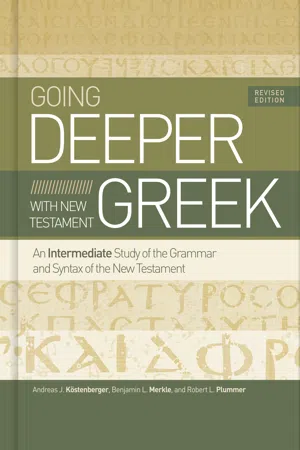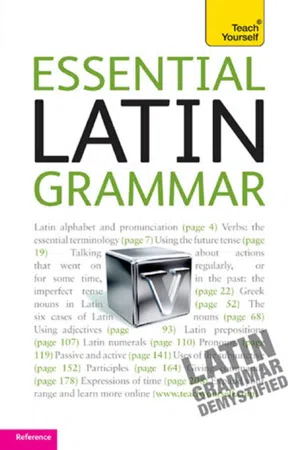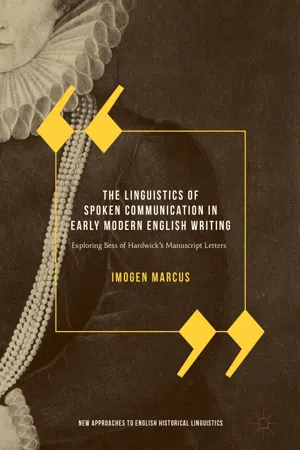Languages & Linguistics
Vocative Case
The vocative case is a grammatical case used to address or call out to someone or something. It is often marked by changes in the form of a noun or pronoun, and is commonly found in languages with inflectional morphology. The vocative case helps to indicate the person or thing being directly spoken to within a sentence.
Written by Perlego with AI-assistance
6 Key excerpts on "Vocative Case"
- eBook - ePub
- Andra Kalnaca(Author)
- 2015(Publication Date)
- De Gruyter Poland(Publisher)
Plungian (2011 , 178–179) for the historical analysis of these considerations).Nevertheless, the form and function of the vocative allow for this case to be considered an integral part of the noun case paradigm, instead of just a word formation phenomenon (for this viewpoint see Nau 2011 , 146).First of all, it should be emphasised that morphologically the vocative is not a form that would exist outside the paradigm (see Paulauskienė 1994 ; Kalnača 1999 ; Holvoet 2012 , 47). The vocative is connected with the rest of the cases by the common stem of the noun as well as the specific grammatical form whose main function is the naming of the message addressee (Plungian 2011 , 178). The vocative is the case used for calling someone or getting their attention (Matthews 1997 , 397) and its function in a language system is to attract the attention of a message addressee to specific information.A range of the vocative forms inherited from the Baltic and Indo-European proto-languages remain in use in Standard Latvian (1st, 4th, and 5th declensions). The vocative ending of these forms has been phonetically reduced due to the shortening of final syllables (Rudzīte 1993 , 181–184), i.e., the ending is a zero morpheme, for example (see also Table 1.5 , Section 1.2 - eBook - ePub
Going Deeper with New Testament Greek, Revised Edition
An Intermediate Study of the Grammar and Syntax of the New Testament
- Andreas J. Köstenberger, Benjamin L Merkle, Robert L. Plummer(Authors)
- 2020(Publication Date)
- B&H Academic(Publisher)
51USES OF THE VOCATIVE Direct Address Direct Address
The most common use of the vocative in the NT involves the use of a substantive without the article to identify the person or thing that is being addressed.52• κύριε , ἐὰν θέλῃς δύνασαί με καθαρίσαι (Matt 8:2)Lord , if you are willing, you can make me clean• διδάσκαλε , ἤνεγκα τὸν υἱόν μου πρὸς σέ (Mark 9:17)Teacher , I brought my son to you• Λάζαρε , δεῦρο ἔξω (John 11:43)Lazarus , come out!In this case, the noun in the vocative is a proper name, Lazarus.• ἀναστάς , Πέτρε , θῦσον καὶ φάγε (Acts 10:13)Get up, Peter ; kill and eat!• σὺ δέ , ὦ ἄνθρωπε θεοῦ , ταῦτα φεῦγε (1 Tim 6:11)But as for you, O man of God, flee these things (ESV)ACCUSATIVE
The accusative case is the case of limitation or extension , delimiting the action of a verb. The accusative “measures an idea as to its content, scope, [or] direction.”53 You may visualize the function of the accusative as indicating “the point toward which something is proceeding” or “the space traversed in such motion or direction.”54 The most frequent idea conveyed by the use of the accusative thus essentially encompasses three elements: the end, direction, or extent of an action.55 In each case, the accusative limits the action. For example, Matthew 22:24 contains the clause, “his brother is to marry his wife” (ἐπιγαμβρεύσει ὁ ἀδελφὸς αὐτοῦ τὴν γυναῖκα αὐτοῦ ). The phrase “his brother is to marry” is completely open-ended, but “his brother is to marry his wife - Gregory Klyve(Author)
- 2013(Publication Date)
- Teach Yourself(Publisher)
4CasesIn this chapter you should aim to • understand the functions of cases in an inflected language • attempt the exercises at the end of the chapterA Nominative and vocative1 Nominatives and vocatives are alike except in the singular of the second declension (see Unit 3E ).2 The subject• The nominative case is the name of a noun and is used when that noun is the subject of a sentence. If the verb of a sentence is active (see Unit 1H ), the subject is the person or thing performing the action of the verb.e.g. mus elephantum terret → the mouse frightens the elephant. The mouse is doing the frightening so it is the subject.• If the verb of the sentence is passive (see 1H and Unit 8 ), the subject is the person or thing experiencing the action of the verb.e.g. mus ab elephanto terretur → the mouse is frightened by the elephant. The mouse is now experiencing the fright so it is the subject.• In English we usually start our sentences with the subject but in Latin the subject can come anywhere in a sentence or clause (see Introduction).e.g. legiones Gallos superaverunt → the legions have overcome the GaulsCaesaerem Brutus necavit → Brutus killed Caesar plaustrum trahunt boves → the oxen pull the wagon3 The complementThe nominative is also used when one noun is the complement of another. In other words, the subject of the sentence is referred to by another noun.- eBook - ePub
- Gregory Klyve(Author)
- 2012(Publication Date)
- Teach Yourself(Publisher)
4
Cases
A Nominative and vocative2 The subject1 Nominatives and vocatives are alike except in the singular of the second declension (see Unit 3 E).• The nominative case is the name of a noun and is used when that noun is the subject of a sentence. If the verb of a sentence is active (see Unit 1 H), the subject is the person or thing performing the action of the verb.e.g.mus elephantum terret→ the mouse frightens the elephant . The mouse is doing the frightening so it is the subject.• If the verb of the sentence is passive (see 1H and Unit 8 ), the subject is the person or thing experiencing the action of the verb.e.g.mus ab elephanto terretur→ the mouse is frightened by the elephant . The mouse is now experiencing the fright so it is the subject .• In English we usually start our sentences with the subject but in Latin the subject can come anywhere in a sentence or clause (see Introduction ).e.g.legiones Gallos supervaerunt→ the legions have overcome the GaulsCaesaerem Brutus necavit→ Brutus killed Caesar3 The complement The nominative is also used when one noun is the complement of another. In other words, the subject of the sentence is referred to by another noun.plaustrum trahunt boves→ the oxen drag the plough4 The Vocative Casee.g.Caesar electus est imperator→ Caesar has been chosen as general . The noun imperator (general ) refers to the subject (Caesar) and so is the complement and is in the nominative.The Vocative Case is used when addressing someone or something.e.g. ave Caesar! → hail Caesar!salvete filii → hello sonssalve sol → hello sunExamples of second declension vocatives are:• et tu Brute? → you too Brutus? (Julius Caesar’s dying words in Latin)• salve Valeri → hello Valerius• o fili → o son5 Technically, the nominative case is known as the casus rectus but you will probably never meet this term. However, you will probably meet the term - eBook - ePub
The Linguistics of Spoken Communication in Early Modern English Writing
Exploring Bess of Hardwick's Manuscript Letters
- Imogen Marcus(Author)
- 2017(Publication Date)
- Palgrave Macmillan(Publisher)
2006 study of vocatives in Shakespeare’s EModE literary language). The present chapter takes an in-depth, qualitative look at vocatives in non-literary EModE epistolary language.This chapter investigates the distribution and grammatical position of individual vocatives in the Bess corpus, and contextualizes this investigation with reference to their distribution and function in the CEEC. The research questions addressed are as follows: are there any similarities between how vocatives are used in these EModE written letters and how they are used in PDE conversation? Is scribal variation present in relation to the use of vocatives in the Bess corpus? Is social variation present in relation to the use of vocatives in the Bess corpus? How do these results compare to how key vocatives pattern in the CEEC? In this chapter I will first discuss the definition of a vocative, including vocative categories, before moving onto where vocatives are most likely to appear in EModE letters. The chapter will then describe the methodology used, discuss the results obtained and provide a summary and some concluding remarks.6.2 What Is a Vocative?
The word vocative comes from the Latin stem vocare , which means ‘to call’ and can be said to literally mean calling out to someone.1 Quirk et al. (1985 : 612), morpho-syntactically classify present day English vocatives, among several other linguistic features, as ‘disjuncts’ . Disjuncts have ‘a superior role as compared with the sentence elements. They are syntactically more detached and in some respect superordinate in that they seem to have a scope that extends over the sentence as a whole’.2 PDE spoken conversation often contains these ‘disjuncts’ , or what Biber et al. call ‘non-clausal material’ (cf. 1999 : 1099–1108). For Biber et al., non-clausal material is a catch-all category which includes elliptic replies, condensed questions, echo questions, elliptic question and answer sequences, condensed directives, condensed assertions, elliptic exclamatives, other exclamatives, various polite speech acts, phrases functioning as prefaces and tails, and crucially for this chapter, vocatives. This kind of non-clausal material is often not only syntactically detachable but also semantically omissible, making it symptomatic of the looser structure and integration that Leech (2000 ) and other scholars have found in modern day English speech . As PDE speech is used as a benchmark to see the extent to which early modern English writing reflects spoken communication - eBook - ePub
On Case Grammar
Prolegomena to a Theory of Grammatical Relations
- John Anderson(Author)
- 2018(Publication Date)
- Routledge(Publisher)
1 GRAMMARS OF CASE 1.1 A Traditional Notion of Case The grammatical terminology of most languages which incorporate the European tradition in such matters displays a systematic ambiguity in the use of the term ‘case’. Usually, it is employed to refer both to a certain inflexional category (and the forms that manifest it) and to the set of semantic distinctions carried by the forms of that category. We can differentiate these as case-forms and case-relations or case-functions respectively. Thus in Lutetiam veni, it might be said that the noun is in the ACCUSATIVE form and that in this instance it indicates, or functions as, the ‘goal’. Much controversy has depended simply on the confusion of these two senses. Certainly, such an ambiguous usage has the disadvantage that case-functions clearly can be expressed in other ways, notably by prepositions or postpositions, by word order or in the morphology of the verb rather than the noun. In what follows I shall use the term CASE-FORM (henceforth CF) more inclusively, to cover any form that serves to express a CASE-RELATION (henceforth CR), where the latter are interpreted as labels for the semantic role that a particular NP fulfils in the predication. Most traditional accounts posit a complex mapping between the set of CRs and the set of CFs (either in the narrow sense or interpreted, as I propose, more widely). For instance, the same accusative form of Latin we noted above as a marker of the goal relation can also express the (DIRECT) OBJECT, as in puellam amo. And the goal can alternatively be associated with a form which includes a preposition: ad urbem veni There have been rather few attempts to arrive at more NATURAL accounts, that is, descriptions of the CR/CF relationship which involve less of a discrepancy
Index pages curate the most relevant extracts from our library of academic textbooks. They’ve been created using an in-house natural language model (NLM), each adding context and meaning to key research topics.
Explore more topic indexes
Explore more topic indexes
1 of 6
Explore more topic indexes
1 of 4





